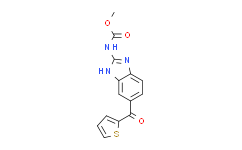| Description: |
Nocodazole is a rapidly-reversible inhibitor of microtubule. Nocodazole binds to β-tubulin and disrupts microtubule assembly/disassembly dynamics, which prevents mitosis and induces apoptosis in tumor cells. |
| Target: |
Abl:91 nM (Kd)
ABL(E255K):120 nM (Kd)
ABL(T315I):170 nM (Kd)
BRAF:1.8 μM (Kd)
BRAF(V600E):1.1 μM (Kd)
c-KIT:1.6 μM (Kd)
MEK1:1.7 μM (Kd)
MEK2:1.6 μM (Kd)
MET:1.7 μM (Kd)
PI3Kγ:1.5 μM (Kd)
Microtubule/Tubulin
CRISPR/Cas9 |
| In Vivo: |
Nocodazole (5 mg/kg/three times per week, i.p.) has antitumor effects in athymic mice bearing COLO 205 tumor xenografts. Nocodazole (1 nM) + ketoconazole dramatically increase the levels of p21/CIP1 and p27/KIP1 protein in the tumor tissues[4]. |
| In Vitro: |
Nocodazole exhibits good affinity toward c-KIT, with a Kd value of 1.6 μM in highly malignant human cancer cells. Nocodazole displays good binding affinity toward the components of the mitogen-activated protein kinase (MAPK) pathway, such as BRAF (Kd=1.8 μM), BRAF(V600E) (Kd=1.1 μM), MEK1 (Kd=1.7 μM), and MEK2 (Kd=1.6 μM)[1]. Nocodazole has the highest affinity for αβIV and the lowest affinity for αβIII[2]. After release from the nocodazole block, cells synchronized in mitosis remaine sensitive to very low concentrations of paclitaxel for < 30 min, the time required for spindle formation, yet remains sensitive to vinblastine for > 90 min[3]. Nocodazole (1 nM) induces apoptosis of COLO 205 cancer cells[4]. Nocodazole (≥ 30 µg/mL) significantly increases the percentage of annexin-V-binding cells without significantly modifying average forward scatter of human erythrocytes[5]. |
| Cell Assay: |
Proteins are loaded at 50 μg/lane and separated by 12% (w:v) sodium dodecyl sulfate-polyacrylamide gel electrophoresis, blotted, and probed with antibodies for cyclin E, p53, p21/CIP1, p27/KIP1, glyceraldehyde 3-phosphate dehydrogenase (GAPDH), cyclin A, cyclin D1, cyclin D3, cyclin B, CDK2, CDK4, and cytochrome C. Immunoreactive bands are visualized by incubating with the colorigenic substrates nitroblue tetrazolium and 5-bromo-4-chloro-3-indolyl-phosphate. The expression of GAPDH is used as the control for equal protein loading. |
| Animal Administration: |
COLO 205 cells are grown in RPMI 1640 supplemented with 10% FCS. Cells are harvested through two consecutive trypsinizations, centrifuged at 300×g; for 5 min, washed twice, and resuspended in sterile phosphate-buffered saline (PBS). Cells (5×105) in 0.1 mL are injected subcutaneously between the scapulae of each nude mouse. After transplantation, tumor size is measured with calipers, and the tumor volume is estimated. Once tumors reach a mean size of 200 mm3, animals receive intraperitoneal injections of DMSO (25 μL), ketoconazole (50 mg/kg), nocodazole (5 mg/kg), or ketoconazole + nocodazole three times per week for 6 wk. |
| References: |
[1]. Park H, et al. Nocodazole is a high-affinity ligand for the cancer-related kinases ABL, c-KIT, BRAF, and MEK. ChemMedChem. 2012 Jan 2;7(1):53-6.
[2]. Keliang Xu, et al. Interaction of nocodazole with tubulin isotypes. Drug Development Research 2002
[3]. Long BH, et al. Paclitaxel inhibits progression of mitotic cells to G1 phase by interference with spindle formation without affecting other microtubule functions during anaphase and telephase. Cancer Res. 1994 Aug 15;54(16):4355-61.
[4]. Wang YJ, et al. Ketoconazole potentiates the antitumor effects of nocodazole: In vivo therapy for human tumor xenografts in nude mice. Mol Carcinog. 2002 Aug;34(4):199-210.
[5]. Signoretto E, et al. Nocodazole Induced Suicidal Death of Human Erythrocytes. Cell Physiol Biochem. 2016;38(1):379-92.
[6]. Zhang JP, et al. Efficient precise knockin with a double cut HDR donor after CRISPR/Cas9-mediated double-stranded DNA cleavage. Genome Biol. 2017 Feb 20;18(1):35. |






















